David Dunlop, 02 December 2020.
According to Leadmark 2050, “To meet defence and security challenges in the coming decades, Canada’s maritime forces will need to become better equipped for Maritime operations to maintain our sovereignty and conduct peace-support operations, including rendering humanitarian assistance and relieving distress from the sea.”
Successive Canadian governments have not delivered predictable, sustainable and long-term funding for the Canadian Armed Forces (CAF). Royal Canadian Navy (RCN) ships are examples of the unfortunate link between inadequate investment and capability gaps. The RCN, and Canadians, deserve clear, realistic and fully-funded commitments from our governments. We are now in the troubling position where status quo spending on defence will not even maintain a status quo of capabilities. As a percentage of GDP, we are spending less on defence today than we were in 2005. Our navy has performed superbly despite the resource constraints it faces. But it cannot perform well forever without proper support. Governments have a responsibility to care for the military, and fund it in ways that meet the needs for decades to come.
A maritime state without a navy is like a king not wearing any clothes: sovereignty undressed. The RCN is in a state of deep crisis and decline. It is shrinking and we must act with resolve, and act soon. Because of failures to replace supply ships and destroyers, Canada no longer has the ability independently to sustain deployed task group operations, and must rely on others for at-sea refuelling and logistics support, even in home waters. If we are serious about Canada’s role in the world, then we have to be serious about funding our military. To meet defence and security challenges in the coming decades, the RCN will need to become better equipped for maritime and Arctic operations. It is imperative that we send a strong signal to both our allies and others that we are prepared to stand up for what we believe in as a nation.
It seems however, that modern submarines will not be part of the future mix for the RCN in the foreseeable future. The government rejected a Senate committee recommendation to at least take the first steps in replacing the aging Victoria-class submarines with a fleet of new boats. (“Reinvesting in the Canadian Armed Forces: A Plan For The Future,” April 2017, p. 24, Recommendation 1). In 2017, the Senate defence committee recommended that the federal government respond to NATO calls for member states to improve the quality of their naval fleets and underwater surveillance capabilities by starting the process of replacing the Victoria-class submarines with new boats that have a more enhanced under-ice capability. It also recommended increasing the size of that fleet to 12 submarines to reinforce Canada’s Arctic, North Atlantic and Pacific Ocean defence preparedness.
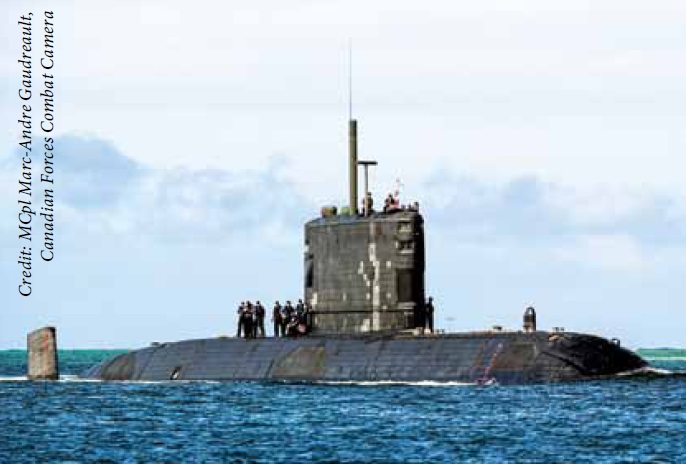
However the government rejected that recommendation. It was the only one of 27 recommendations made by the committee that was rejected outright. The government pointed out in its response in October 2018 that it is in the midst of the most comprehensive fleet renewal in the peacetime history of the RCN, and is recapitalizing and increasing the size of its surface fleet through investments in 15 Canadian Surface Combatants (CSC), two Joint Support Ships (JSS), and six Arctic and Offshore Patrol Ships (AOPS). The government also committed to modernizing the four Victoria-class submarines to include weapons and sensor upgrades that will enhance the ability of the submarines to conduct intelligence, surveillance and reconnaissance, and deliver necessary improvements of platform and combat systems to extend operational capability to the mid-2030s. Canada is also rebuilding the anti-submarine warfare capabilities of the fleet through the introduction of technologies, sensors and weapons while preparing to transition to the future fleet.
So where is the preparation to transition to the submarine ‘fleet of the future’? The Defence Minister has said that upgrading the Victoria-class subs is more ‘prudent’ than buying new subs. The first of the submarines will reach the end of its life in 2022, and the last of the boats would have been retired in 2027. This decision is a political response from the government. Some forces in the government would rather see our submarine service die a thousand deaths than have a National Shipbuilding Strategy (NSS) which incorporates a more robust navy with the purchase of ice-capable modern Air Independent Propulsion (AIP) submarines. This strategy of not preparing the RCN for the future will lead to it to not having a critical capability.
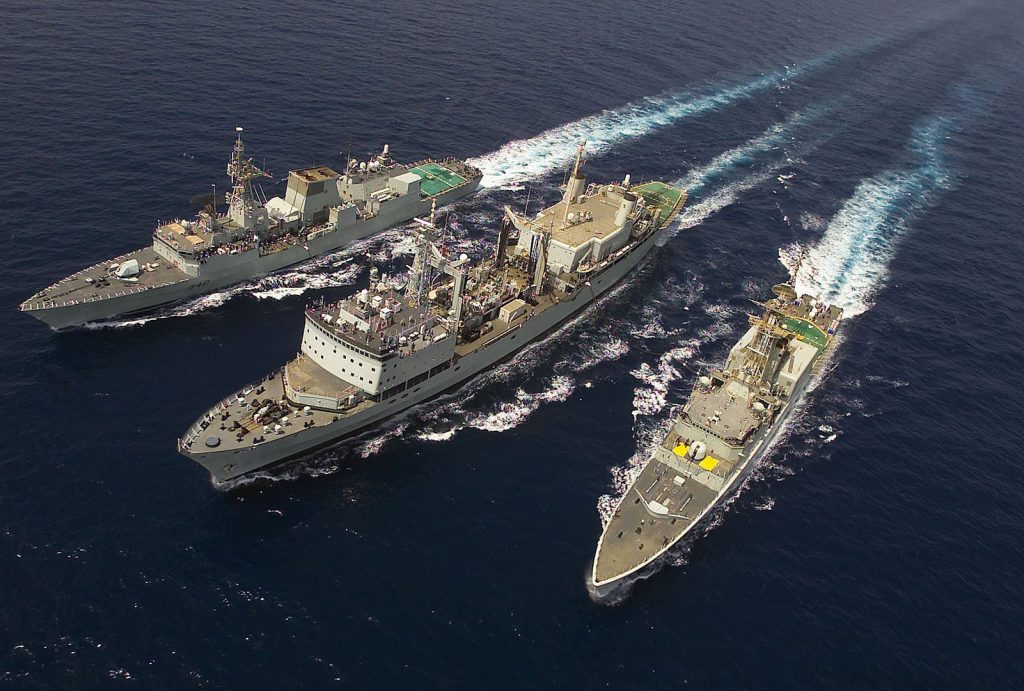
As you may recall, Canada at one time had 4 AAW Iroquois-class destroyers along with 12 Halifax-class frigates, and is replacing them with 15 ASW/AAW capable CSC frigates, which is actually less of a capability than what we had. And we are just now replacing the replenishment ships with 2 Protecteur-class Auxiliary Oiler Replenishment (AOR) ships, which should have happened much sooner. The AOPS will only give a limited presence in the Arctic Ocean.
A credible, strategic sealift fleet of Landing Helicopter Dock/Assault (LHD/LHA) vessels for rapid deployment domestically or globally with humanitarian assistance and disaster relief (HA/DR) capabilities would be an excellent resource. Beyond Canada’s shores, the capability to undertake peace operations, including rendering HA/DR, is a critical requirement for the RCN. The RCN would then be well positioned to contribute meaningfully to domestic action ashore and support the sustainment of joint operations from sea, while preserving the ability to defend Canada through naval operations. An amphibious sealift capability would make Canada a more reliable contributor to national and international operations. The capacity to move and deliver bulk supplies, heavy equipment and medical personnel into areas of HA/DR operations is an extremely costly and limited option when conducted by air, and impossible without functioning airports.
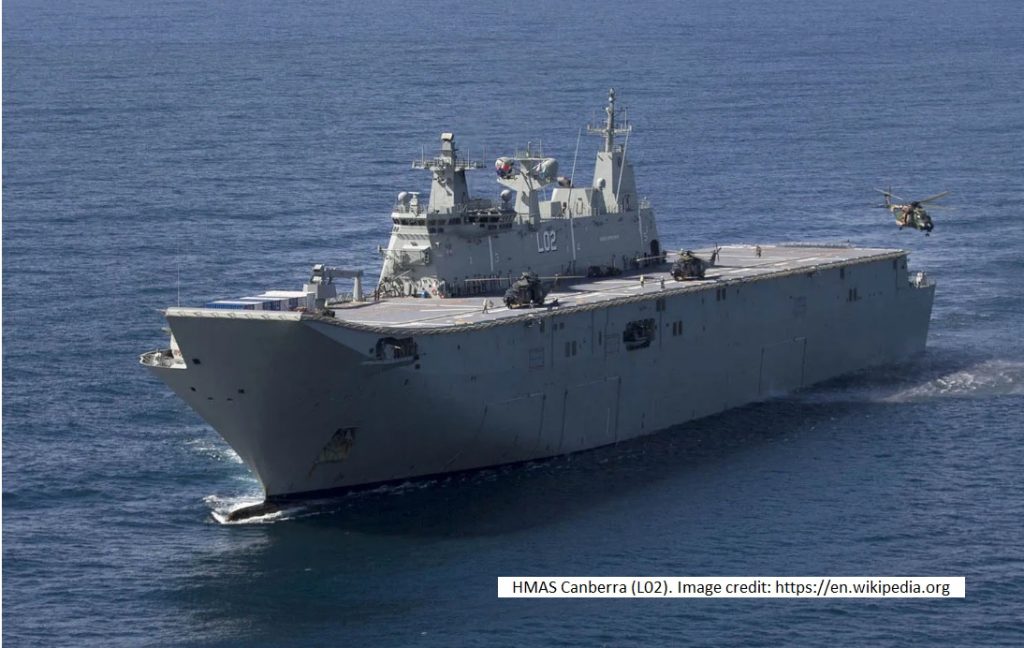
The reality of the current COVID-19 pandemic however, may mean that efforts to increase the effectiveness of the CF will give way to much of the same old myopic, parochial and service-centric approaches to defence that have so often failed Canada in the past. With all the advantages that an amphibious sealift capability provides, it is puzzling why Canada has not adopted this capability like so many of its allies.
During the hearing of the Standing Committee on National Defence in 2017, most witnesses proposed that Canada acquire a large helicopter carrying amphibious peace support capability that the RCN could use for HA/DR, peace support and personnel transport at home and abroad. The planned two Protecteur-class AORs (based on the German Berlin-class) and interim AOR ship MV Asterix, have a small measure of this capability but are designed primarily for replacement of the old AOR fleet supply ships in direct support of long-range operations for the future frigates. They are not designed to carry troop formations or medical field hospitals. Subject to availability, they will not eliminate the reliance on chartered sealift when speed of delivery is a key requirement.
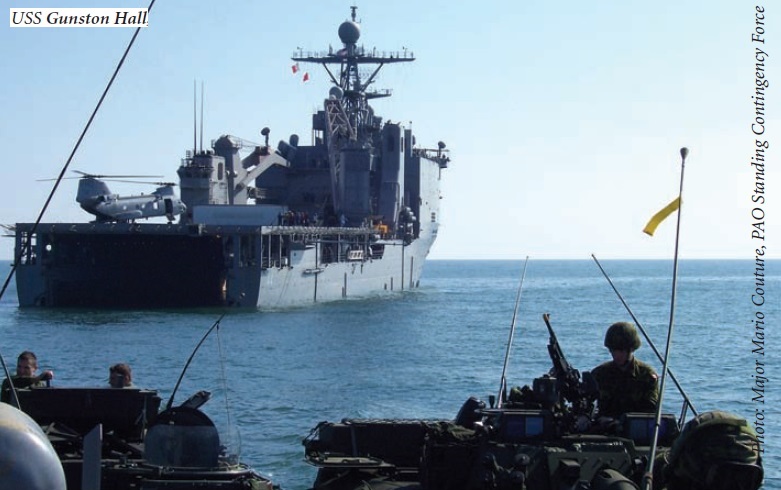
Amphibious ships would provide the RCN with the ability to perform a peacetime helping role which the Canadian public has an expressed appetite for. Canada’s allies agree that an amphibious sealift HA/DR capability brings with it enhanced flexibility to conduct military, peacekeeping and HA/DR operations. The Canadian government has said that Canada will be participating in UN peacekeeping and peace support missions in a more meaningful way. Acquiring a strategic Canadian amphibious sealift HA/DR capability would be essential to this policy. Canada must step up to the plate and give the RCN the tools to accomplish the government’s peace support/peacekeeping and HA/DR missions. The ability to quickly deploy military and/or medical forces over great distances has considerable appeal to a country that wishes to renew its international presence.
It is time for our government to clearly state its intentions and start the process to field a Canadian amphibious sealift HA/DR capability or Canada will never live up to its full potential as an influential middle power. If Canada were to allocate, as a minimum, 2% of its GDP to National Defence annually, this future fleet would not only be possible, but could be built in Canada. To try to accomplish this under current fiscal constraints would be difficult at best unless an increase in defence spending is realized soon. So there you have it. Canada is a state with the longest coastline in the world, which claims a large share of the Arctic Ocean, including what lies on its seabed; Canada, which longs to be a great trading state, simultaneously needs a credible navy to secure the sea lines of communication. That Canada is lacking the bold decisions required to secure its future security and sovereignty. Canada’s navy is in deep crisis, and may not survive if the course and speed are not altered, and soon. It is time to get on with this new fleet and see it through!

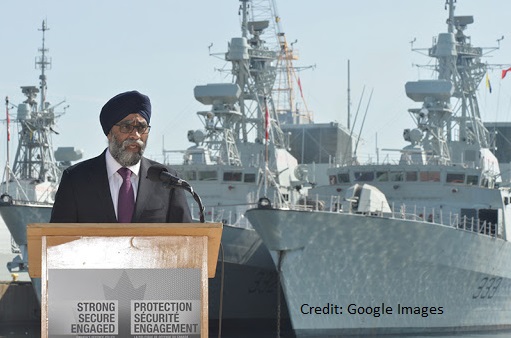
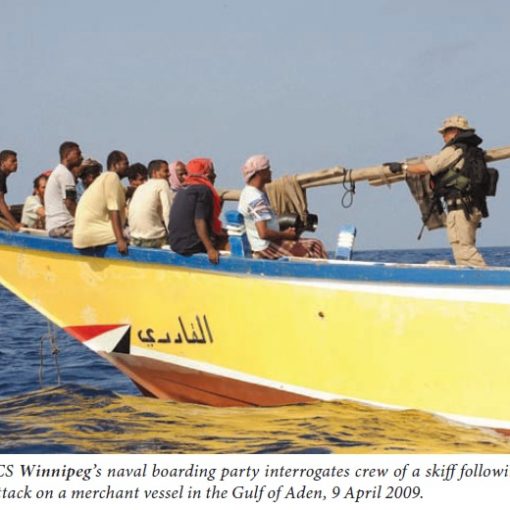

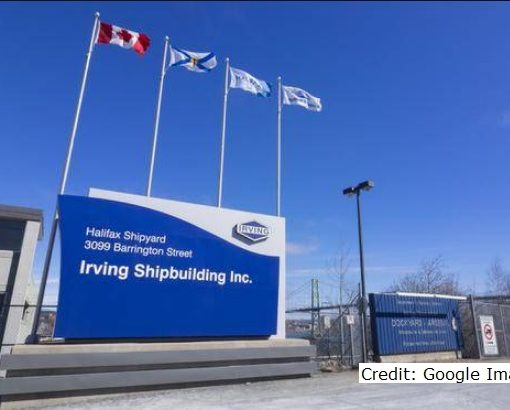
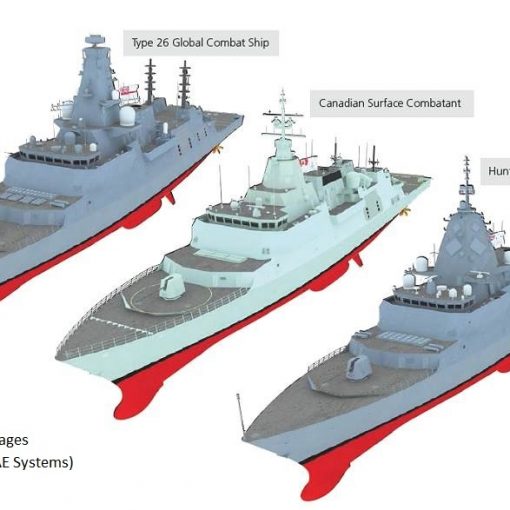
13 thoughts on “Canada’s Navy in Deep Crisis – 2021”
Respectfully, I disagree. Hospitals in Manitoba are in crisis (see refs). The RCN is doing alright.
Yes, we are lacking some capabilities and the fleet requires modernization. We are doing more with less, but it’s been like this since 1910. I would refrain from confusing nostalgia for old times [Cold War?] with actual operational deficiency. Also, good luck adjusting the GDP towards National Defence when economy struggles under COVID-19.
Refs:
https://www.cbc.ca/news/canada/coronavirus-covid19-canada-world-december-2-1.5824702
https://www.navalreview.ca/2020/10/hmc-ships-ville-de-quebec-and-halifax-participate-in-joint-warrior/
https://www.navalreview.ca/2020/10/hmcs-toronto-deployed-on-op-reassurance/
https://www.navalreview.ca/2020/11/hmcs-harry-dewolf-begins-basic-single-ship-readiness-training/
https://www.navalreview.ca/2020/06/construction-contract-awarded-for-joint-support-ships/
Can’t believe an “old-sailor” is saying the RCN is “doing alright”. We have not been “doing alright” for some time now and you above all should know that. Perhaps you believe that the RCN has been “doing so much, with so little, for so long, that, now they are able to do anything with nothing forever”. Wake up and smell what you’re shoveling. There is nothing nostalgic about it. This crisis is real and has been that way for several years now. Canada has become operationally defective as most of our NATO allies have said (quietly) for some time now. I did not say the GDP should be adjusted upwards tomorrow, but it must be seriously considered in the near future (post pandemic of course).
I prefer to substantiate my opinion. Please see the links below. That looks quite ‘alright’ to me. For now. Also, the existence of the NSS tells me that RCN’s shortcomings are identified, recognized and the action plan is already in place. One can argue how well the NSS goes, but that’s a topic for another chat.
Fleet capabilities are developed based on requirements to support naval missions, which are extension of government policy. An organization like DNR provides Mission Assurance and formulates SOCD if certain capability is required, but not achieved.
Let’s examine a hypothetical scenario where in 2027 Russia has territorial dispute with Canada over Cape Breton. At this point Halifax class is at EOL, and the CSC is not ready yet. Now we have a problem, because the Navy may not be able to accomplish its mission #1:
1. Protect Canada by exercising Canadian sovereignty in our home waters, securing the maritime approaches to North America […] Ref: Leadmark-2050
Would such crisis be resolved by employing FRE, KIN, WIN, Harry DeWolf and Asterix? Or RCN would require a “next generation warship”, which will replace both the recently decommissioned 280s and today’s post-HCM frigates? It’s a 60-billion-dollar question, and I believe you know the answer.
I may speculate further about option analysis and the decision-making process, but the point is: we can’t afford building capability ‘just in case’. It has to be backgrounded on government policy, state of economy and relevant TRA. For example, we won’t be getting any LHD/LHA unless you expect a Russian invasion.
It would be awesome to have a fleet of 15 CSC, 12 AIP subs, 6 helicopter carriers, bunch of drones, 2 JSS (with 4 fueling masts each!), and then 2 hospital ships to collect casualties after WW3 starts. But let’s be realistic — it ain’t gonna happen.
Back to your comment on Broadsides: a ‘crisis’ implies ‘urgency’ to prioritize resources and address an immediate issue. I personally don’t see the current situation this way. Hence the NSS vs outright ship purchase.
Respectfully, for your consideration.
References:
https://www.navalreview.ca/2020/11/the-rcn-and-hadr-operations/
https://www.navalreview.ca/2020/11/security-and-good-order-on-the-seas/
https://www.navalreview.ca/2020/12/hmcs-winnipeg-continues-deployment-in-asia-pacific/
https://www.navalreview.ca/2020/09/hmc-ships-regina-and-winnipeg-represent-canada-at-rimpac-2020/
https://www.navalreview.ca/2020/09/hmcs-ville-de-quebec-glace-bay-and-mv-asterix-participate-in-op-nanook-tuugaalik-2020/
https://ml-fd.caf-fac.ca/en/2019/04/26932
https://www.cbc.ca/news/world/keeping-pirates-at-bay-on-board-with-the-canadian-navy-off-the-coast-of-nigeria-1.4590286
http://www.lookoutnewspaper.com/camaraderie-pandemic-operation-caribbe/
https://www.navalreview.ca/2020/07/first-arctic-and-offshore-patrol-ship-aops-delivered/
https://www.navalassoc.ca/wp-content/uploads/2019/05/Leadmark-2050-13-May-2016.pdf
https://www.navalreview.ca/2020/10/canadian-defence-policy-strong-secure-engaged/
Hi old-sailor. Your references for “alright, for now” just doesn’t seem to cut it somehow. The RCN crisis is real today and it will metastasize for the RCN if not altered. The RCN will have a superb CSC frigate in the future, but they have not even begun to develop yet and will have very little HA/DR capabilities. Yes, Fleet capabilities are developed based on requirements to support naval missions, but I argue that those naval missions should include a robust HA/DR capability. This is exactly what the Canadian people and Canadian Senate are arguing for this exact government policy right now. The Juan Carlos class LHD is an excellent HA/DR ship and could very easily be built right here in Canada, if the government had at least “some vision”. HA/DR missions using this type of ship would be a real game change for Canada now and in the future, both at home and abroad. You seem to think these ships are mainly built for war. Yes, they are a tremendous Amphibious Warfare capability for our navy, army and air force, however, their main tasks would involve meaningfully helping with Humanitary Assistance and Disaster Relief both at home and abroad. Believe me, they would be very busy with these missions! We don’t need 6 of these LHDs; probably 2 as Australia has, but no more than 3 (one would normally be in deep maintenance). As for modern AIP submarines, that would be a natural follow-on for the Victoria class. Yes, 10 to 12 of them would be just about right as the Canadian Senate committee has asked the government to do, but we all know what our government has said on that issue. Trying to substantiate your position and using hypothetical scenario’s is not helpful for the RCN, and I believe you would be more accurate to give the RCN the tools they require soon to do the job of that most Canadians expect of their Navy.
Future Ship Capabilities
Back in 2009, the RCN held a type of forward-thinking workshop whose goal was to produce a number of “vision” papers, each outlining a specific capability-to-role outlook for the navy of the future. I believe Caspar Donovan was involved with this hypothetical enterprise in some capacity.
Of the five “Vision Papers” produced, one in particular departed dramatically from the RCN’s traditional focus on higher-end surface combatants. This paper contemplated a fleet of 10-12 flexible, multi-role warships, along with 6-8 AOPS, and 4 conventional submarines.
The operational concept was for two continuously deployed and self-sufficient multi-role warships that would emphasize jointness and would provide multi-purpose platforms to support Ottawa’s broader foreign policy objectives, and would be highly responsive to the directives of the then Department of Foreign Affairs and Industry Trade Canada.
Under this “Vision”, the RCN would require no joint support ships because the envisioned warships would have an 8,000-10,000 nm range, and would possess a flex deck capable of handling several military or other vehicles and related equipment, containers, supplies, a field hospital and/or a joint headquarters. The ship would rely heavily on unmanned vehicles and weapons packages, probably in modular form. Its war-fighting capabilities would feature a Mk 41, or related, VLS, and a highly capable sensor suite geared to the weapon/sensor modules. It could also operate two Cyclone-type maritime helicopters.
This warship seems very much like the Littoral Combat Ship under development in the U.S. at the time, or even moreso like the Absalon-class combat support frigates which had been in service with the Royal Danish Navy since 2005. These latter ships were a hybrid between a naval frigate and a military transport ship, and featured multiple role capabilities.
Nothing came of this particular speculative thinking, perhaps because it would require some form of major navy support in any high-end conflict.
In any case, this exercise, however speculative it was, does show that the Navy was at least giving some thought to the concerns you express in this post.
Hi Dan. Nice to hear from you again. Seems that it was a great “paper exercise”, but again nothing has come of it from the government for some years now. Spain has I believe the best option for Canada in the Juan Carlos class LHD, A 27,500 tonne ship that could be a great intro for Canada to acquire two of these purpose built Strategic Amphibious Sealift Capabilities and would be just about ideal as an Humanitarian Assistance/Disaster Relief response from Canada either home or abroad. Australia has already acquired two of these vessels for their Navy and I believe with proper training/manning Canada could do the same. Costs would be about the same (or maybe even less) than our two JSS ships. My opinion anyway. Cheers!
David, a Canadian derivative of the Juan Carlos (or ideally 2 or 3 of them) would look great flying the Maple Leaf flag, but there is another, more cost effective option. Fincantieri has a huge shipyard just across Lake Superior from you guys, and that company has recent real world experience building LHA/LPD’s and full blown aircraft carriers for the Italian Navy. In fact they have a sort-of miniature LPD (the “San Giorgio” class) that displaces about 8,000 tons. This is probably too small for Canada’s needs in the stormy Atlantic, but these vessels will soon be replaced by a new class that is twice the displacement–but still considerably smaller and cheaper than Juan Carlos. If it were up to me, I’d buy 3 of the new LPDs. That would be plenty for what you need. Add in 6 new top of the line AIP or lithium battery diesel-electric boats and you’re in business.
I think the RCN is NOT in crisis. The RCN certainly has a lot of challenges throughout its history stemming back from its inception in 1910 and the challenges it’s facing now and in the future is no different from what it’s faced in the past. ALL navies face challenges. It’s how you face these challenges which is important.
[…]
Canada’s Navy is on a steady course of a balanced, multipurpose, combat effective fleet renewal and with new arctic capabilities in the North, regaining lost capabilities to continue protecting our sea lanes and project global power, forward postured, survivable, adaptable and agile all points for a Blue Water navy. So there you have it, we have challenges but hardly a crisis.
Read the full article at https://www.navalreview.ca/2020/12/the-navy-is-not-in-crisis/
Quite a bit is known about the CSC and what capabilities it will have and what missions it will carry out. All ships of the RCN can carry out HADR missions to one extent or another and this ship is no different. The ship can carry the Cyclone, land the Cormorant, have ships boats, personnel and embark numerous 20ft ISO for HADR support. The San Carlos is a nice platform, but do we have the resources now or in the future to support such a vessel?, do we have the doctrine, the aircraft, or simple things like the dock space, or the personnel to crew such a ship. The Protecteur Class that they are currently building will have a significant HADR response capability with the embarkation of ship to shore connectors, a real game changer.
David your view of the RCN is realistic. A look alongside in Halifax will show more CPFs in maintenance than ready to go. The AOPS are behind and overbudget.
Asterix has its flaws but it is far better than what we had once the classic Protectors were retired. Having had a tour recently this vessel’s capabilities are impressive. But more can and should be done.
From my uneducated view the height of the tween deck should have been higher to accommodate larger vehicles. The storage of shipping containers is impressive as all are accessible for emptying while stored inside with travel ability to the flight deck.
Obelix should be built to a reduced AOR capability but with more attention to RoRo capability via a side door and ramp. The room is there to do this.
As has been stated this and Asterix would be the busiest ships in the fleet. The politics need to be removed.
Great article.
Novascotiaboy
It is time Canada started defending itself instead of relying on other countries to defend us.
Well, you know the old saying. “Canadians will defend Canada to the last American”.
A good comprehensive article overall, but the following sentence is entirely erroneous: ‘As you may recall, Canada at one time had 4 AAW Iroquois-class destroyers along with 12 Halifax-class frigates, and is replacing them with 15 ASW/AAW capable CSC frigates, which is actually less of a capability than what we had.’
Other than top speed, there is simply no comparison when it comes to the capabilities of the CSCs over the Halifax class ships.